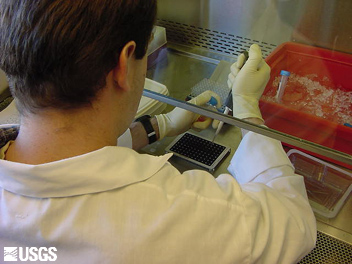- Home
- About S&T
- Taxa/Organisms
- Ecosystems
- Issues
- Methods & Tools
- Reports & Publications
- Location
- Search
Publisher: USGS | Science Center: Western Fisheries Research Center (WFRC, Seattle) | Format: URL
wfrc.usgs.gov — In an attempt to decrease pesticide pollution of aquatic ecosystems, we have begun a project to develop biological control agents to protect plants against fungal diseases. This study has three objectives: (1) understanding how fungi cause disease; (2) understanding how plants that are symbiotic with certain fungi are resistant to fungal diseases; More...

Publisher: USGS | Science Center: Western Fisheries Research Center (WFRC, Seattle) | Format: URL
wfrc.usgs.gov — Many diseases of trout and salmon persist in our cultured fish stocks today, despite improvements in fish culture practices and years of research on vaccines and chemotherapeutants. An excellent example is bacterial kidney disease (BKD), caused by the bacterium Renibacterium salmoninarum. Infections by R. salmoninarum are considered by many to be More...

Publisher: USGS | Science Center: Western Fisheries Research Center (WFRC, Seattle) | Format: URL
wfrc.usgs.gov — A management decision was made in 1994 to increase survival of migrating juvenile salmon by increasing the proportion of river water and fish passed via spill at Snake and Columbia river dams. One result of this action was an increase in dissolved gas supersaturation, which can lead to gas bubble disease in fish. This disease can lead to More...

Publisher: USGS | Science Center: Western Fisheries Research Center (WFRC, Seattle) | Format: URL
wfrc.usgs.gov — Anadromous salmonids are susceptible to a variety of pathogenic microorganisms, including at least 30 bacteria and viruses. Whereas the impact of these microorganisms on salmonids in wild and natural rearing areas is difficult to measure, losses from disease among hatchery salmonids are both common and well documented. The immunology laboratory More...

Publisher: USGS | Science Center: Western Fisheries Research Center (WFRC, Seattle) | Format: URL
wfrc.usgs.gov — Viral infections are common causes of disease outbreaks and mortalities in both wild and captive fish populations. Due to the long history of virus outbreaks there is a substantial body of knowledge about viruses within the field of fish pathology. This project involves research and development studies which create, modify and apply modern More...

Publisher: USGS | Science Center: Western Fisheries Research Center (WFRC, Seattle) | Format: URL
wfrc.usgs.gov — Bacterial kidney disease (BKD) is caused by Renibacterium salmoninarum and is considered to be the most difficult salmonid bacterial disease to control, in part because of its dual modes of transmission. This bacterium, unlike most other fish pathogens, is transmitted vertically from parent fish to progeny in association with the eggs, as well as More...

Publisher: USGS | Science Center: Western Fisheries Research Center (WFRC, Seattle) | Format: URL
wfrc.usgs.gov — Bacterial kidney disease (BKD) caused by Renibacterium salmoninarum has been implicated as a significant factor in the 5-year decline of the chinook salmon populations in Lake Michigan that began during 1988. In 1999, researchers at the WFRC began a multi-year study in coordination with Great Lakes fishery biologists to examine the role of BKD in More...
